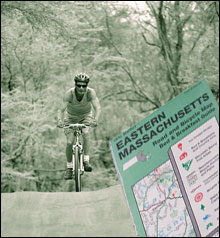
IT BEATS WALKING: A bike's a convenient compromise on and off the beaten path. |
In a car, roaring down highways or rolling over country roads, there is much you will not see and much you will not feel. On your two feet, hiking up a hill or rambling woodland paths, one stride at a time, there are only so many miles that you can cover, only so much territory you can explore. A bicycle, slower than an auto, faster than your feet, connects you to the road in a way cars do not allow and lets you log more miles than if you walked. You won’t smell the pines or hear the gurgle of a creek if you’re buckled into a car (unless you ride doggy-style with your head out the window, but that can’t last long; your eyes will dry up and inevitably the driver will yell something about decapitation). And you certainly won’t be able to travel 40 miles in an afternoon — going from city to suburb to full-force nature — if you’ve got only your two little legs to carry you.For the next eight weeks or so (10 or 12 if your internal thermostat is high or you’ve got a super sleeping bag), while the nights are warm enough to sleep outside, an option to consider is bicycle camping. Instead of overloading the trunk with gear and junk, or chafing your shoulders under the weight of a backpack, start pedaling, because there are many options for two-wheeled overnights not far from Boston.
Andy Rubel of Rubel BikeMaps quit his job in computer software to figure out how to make a living in a cycling-related field. “What I wanted was a bike map of Eastern Massachusetts,” Rubel says. “I was frustrated with piecing routes together, spending hours figuring out how to get from [point] A to B.” So Rubel set out to create that map. “I did it for me,” he says. Based in Cambridge, he’s been making bike maps since 1992.
He started by developing routes to ponds and places to go swimming. His comprehensive Eastern Massachusetts map notes roads that are good for cycling (marked in green), and roads that are less bike-friendly (marked in pink). “Green roads are going to be really pleasant,” he says. “Pink ones won’t be as pleasant, but for a cyclist comfortable riding on the road, they’ll be okay.” The map includes a chart of state parks that notes facilities and camping sites. “If you want to go camping in Eastern Massachusetts, the map shows you where and how to get there.”
Rubel cites about half a dozen parks around here that allow bicycle camping. Harold Parker State Forest (1951 Turnpike Street, North Andover, 978.686.3391) is 3000 acres “and it’s pleasant to bicycle there” from Boston, says Rubel. Camping fees for Massachusetts state parks are minimal, between $8 and $20.
“It’s not quite as pleasant to bike to Salisbury Beach State Reservation; you have to go on 1A,” says Rubel, but the reservation has expansive camping space. (Beach Road, Route 1A, Salisbury, 978.462.4481)
South of Boston, there’s Wompatuck State Park (Union Street, Hingham, 781.749.7160) — “a big park, a really nice park,” Rubel says, with bike paths and mountain-biking trails.